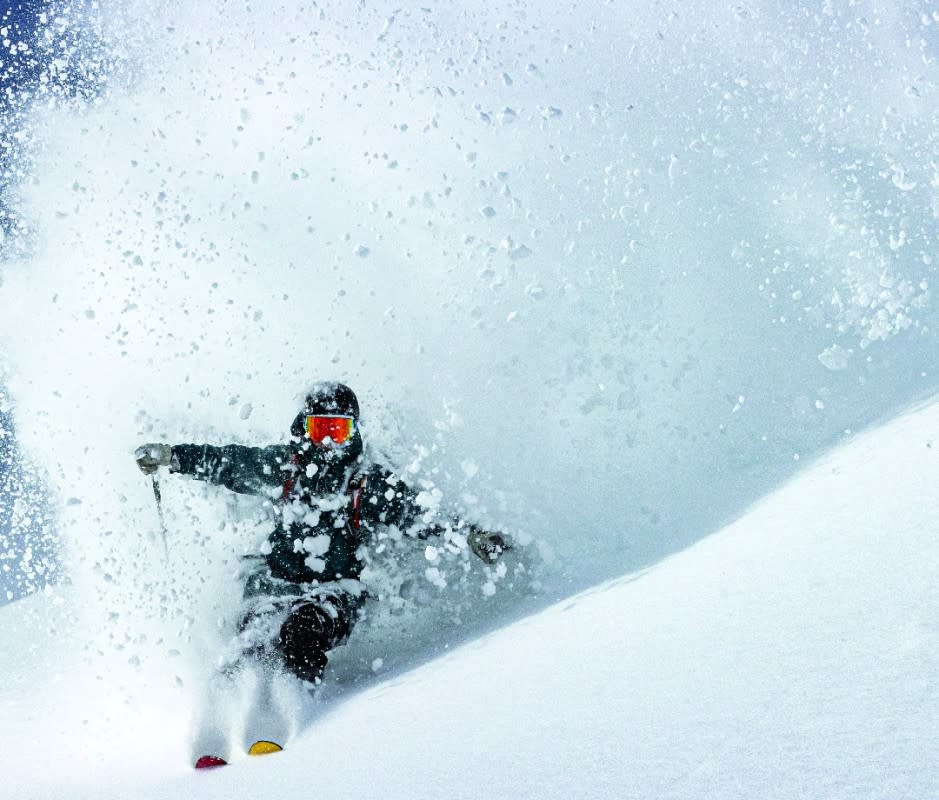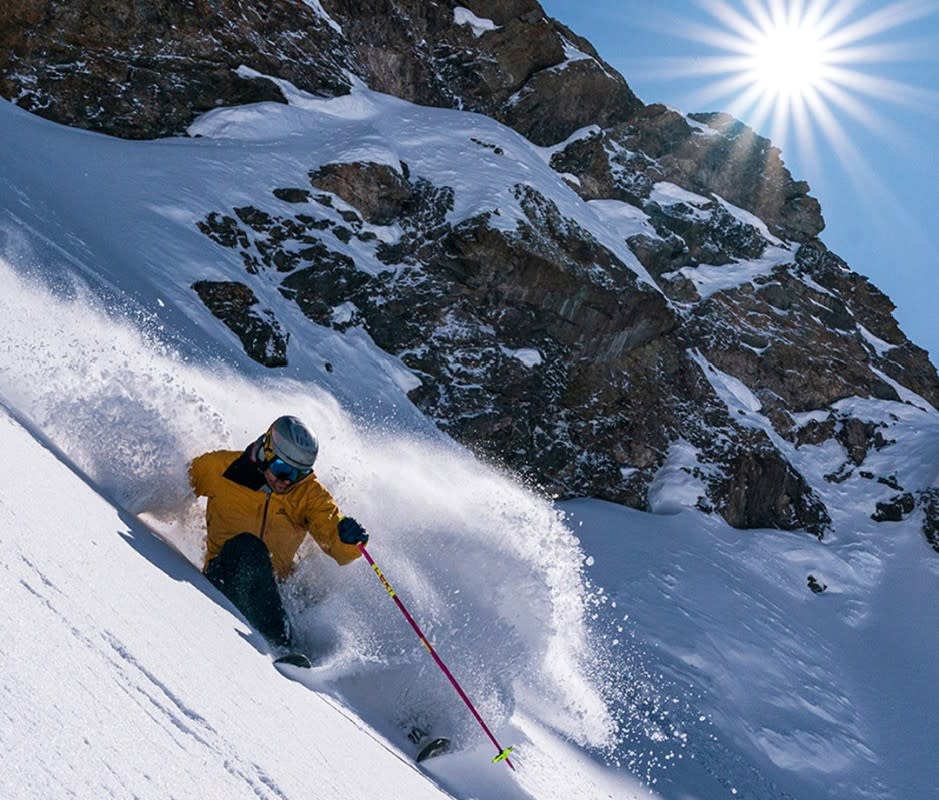The Best New Ski Jackets of 2024 That Will Stand Up to Any Slope
There are two types of skiers. Those who head into the lodge or hit the hot tub the moment the weather gets adventurous, and those who are stoked for Mother Nature’s wilder moods. We picked out these jackets for the latter group. But even if you’re a bluebird day-only skier, these superior, all-weather shelters will let you ski longer and harder because you’ll be warm, dry, comfortable, and perhaps most importantly, confident.
These fully featured, movement-friendly jackets are designed for when you’re dealing with unpredictable weather: rain, sleet, snow, and even pounding storms. Some come with light insulation, others are simply shells. All of them are reliable armor against the elements. Our favorite overall pick for 2024 is the mighty Mammut Nordwand Pro HS Hooded Jacket which hits all the essential chords flawlessly, from fit to function.
Related: Best Small Ski Resorts to Avoid the Crowds
When selecting the best of the best for 2024, we considered the perfect anatomy of the ski jacket. Our criteria are fabric, features, function, fit, and versatility. We looked at fabric for its effective waterproof and breathable properties, DWR (durable water repellent) treatments, and durability.
Features are also important. Our testers are sticklers about helmet-friendly hoods that stay in place (especially under wind load) and pockets that keep go-to essentials at-the-ready. Function is critical. Are the elbows articulated? Is the cut in the shoulders wide enough? Are the wrist and powder skirt closures snug and comfortable?
Related: Powder Paradise: Snowcat Skiing at Colorado’s Purgatory Resort
Fit is a bit more individual. Some testers love a loose-fitting freeride style, while others find comfort in an athletically-cut garment. Versatility is a must. These jackets are designed for skiing, but they also need to look good around town. Tailored for all the right situations, the following 17 jackets confirm that the finest ski gear within your budget is the best investment between here, the top of the gondola, and beyond.

Courtesy of Patagonia
Our Testing Process: Why You Should Trust Us
Our team of nine testers knows how to do our homework out in the field. Collectively, we’ll rack up more than 1,000 on-snow days in a given season just testing out ski gear to see if it lives up to its promise. Most of us have been running ski apparel through the ringer in every type of alpine terrain and weather condition imaginable for over 20 ski seasons.
We’ve run glades, bowls, couloirs, steeps, and remote backcountry in this gear—and we’ve taken copious notes. We’ve skied the slopes of New England and Eastern Canadian hardpack, Whistler powder, Pacific Northwest cement, and everything in between, including months in the French, Italian, and Swiss Alps. We offer a combined ski history of more than 100 years of high-level race and big-mountain experience racked up from Japan to North America to the Alps—and we know exactly what we want and need from the gear we’re relying upon. We also love being dazzled and inspired by the latest, greatest ski gear innovations, which never stop.
We’ve rigorously tested and compared thousands of items, harnessing not only ambition, but wisdom and experience, with testers from their early 20s to seasoned vets. We also tested a lot of this stuff with less experienced skiers to assess their own valuable takes. It's never easy putting so much great ski gear and apparel through its paces before whittling it all down to our favorite performers—but it's always a ton of fun.
How to Layer for the Slopes
The ideal outfit for skiing or snowboarding starts from next-to-skin and works out. You’ll want a wool or synthetic base layer (aka long underwear). Base layers should have a fairly sleek fit, as you don’t want air between them and your body. However, if you wear your “longhandles” as a standalone layer for post-ski drinks and dinner, think about moving up a size. The midlayer you select for the day is determined by temperature and activity. Midlayers should be versatile; think vests, light sweaters, and weightless down puffys. Think of your outer layer as your ski uniform. This hardshell (waterproof and breathable nylon or polyester material) is your first line of defense against the elements.

Liam Doran
Color: How to Choose the Right Shade and Look
Color is safety in the mountains—and style-wise it's making a comeback. Even if you lean black, brown, white, or beige in your personal color preference, know that a pop of brightness in your jacket, pants, helmet, or goggles helps you express your sense of fashion freedom, and individuality—and makes you safer.
Consider a bright jacket, add a neon helmet, vibrant mittens, or a splashy neck gaiter to stick out—in a good way. Ski apparel shouldn’t be camouflage, causing you to blend in with snow, rock, cliff bands, and trees. Ideally, you won’t end up in a tree well, snowdrift, or crevasse, but bright apparel does help your friends keep track of you in the lift line and on the slopes. Those same rules apply if you’re deep in the backcountry, where visibility makes all the difference in a rescue scenario. Finally, with color, you’ll look better in photos.
You need to wear to believe. Here are the 17 best new ski jackets for any skier’s wardrobe this year.
Men’s Journal aims to feature only the best products and services. We update when possible, but deals expire and prices can change. If you buy something via one of our links, we may earn a commission.
Best Overall Ski Jacket of 2024: Mammut Nordwand Pro HS Hooded Jacket
Designed for serious skiing and alpine climbing (because sometimes they go hand-in-hand), this benchmark setup has probably topped out on more of the world’s peaks than any other jacket. The Swiss designers who created this kit, along with world-class athletes, have fine-tuned the Mammut Eiger Pro Nordwand Jacket. This iteration has a shell made from light but durable pre-consumer recycled nylon Gore-Tex Pro, with Gore-Tex Stretch mapped into areas for a bespoke fit. The fit is classically athletic and sleek (read not baggy), but with great range of motion for swinging ice axes, poling, and even some full-on climbing on those days when you’re having to work to reach that untracked couloir. The jacket includes one-handed (glove friendly) adjustment for hood and hem, waterproof zippers, and 19-inch underarm vents for dumping heat.
Best Ski Shell Jacket: Arc’teryx Sabre SV Jacket
Drool-worthy is an overused term, but that’s how our crew described the new Sabre SV Jacket. This piece is serious armor against rain, sleet, wind, and snow—providing a generous fit (more freeride than alpine) that's built for severe conditions. The attention to detail, from the key lock mechanism that connects the jacket’s spray skirt to the bibs to the highly adjustable hood with its stiff brim, is impressive. While the fabric isn’t as “silent” as we’d like, the breathable Gore-Tex Pro Shell stood up to torrential downpours on multiple wet New England ski days. It’s one of the longest snow sports shells we tested, and the extra length in the back was welcome protection when the chair lifts were iced up. Made to regulate temperature, the Sabre Insulated Midlayer ($350) combines air-permeable face fabric for airflow and vapor transport with synthetic insulation that really breathes.
Best Budget Ski Jacket: Columbia Titanium Highland Summit Jacket
This Titanium Highland Summit ticks all the boxes when it comes to a bomber ski jacket. It's a technical marvel with Columbia’s latest Omni-Heat Infinity reflective technology (read warmth without weight), plus a wealth of features including underarm zippers for venting, plenty of pockets, a helmet compatible hood, and sealed seams to keep out wind, rain, and snow. Testers (especially the taller ones) appreciated the longer cut. We also love this jacket as it comes in the standard sizing, but also Big and Tall, XL and XXL. Plus, it has the best price of any jacket with similar technology. You’ll still have money left over for your season pass.




















